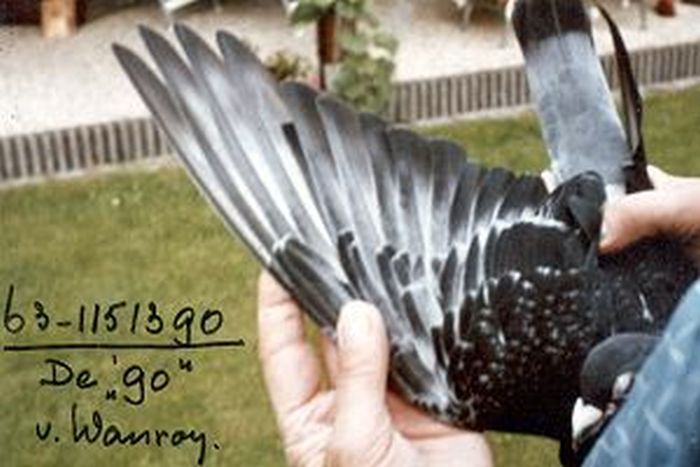Jef Van Wanroy
Jef Van Wanroy, Master Breeder & Racer, was born 1904, in Broekhuizenvorst, Holland.
- Steve O'Dea
- March 24, 2021
- 12:34 pm
Watch, Listen or Read about the Van Wanroy Pigeon Family below here....
 “The name “Jef Van Wanroy” may not have been familiar to the English speaking fanciers, but in Holland it was, and is, a household name.”
“The name “Jef Van Wanroy” may not have been familiar to the English speaking fanciers, but in Holland it was, and is, a household name.”
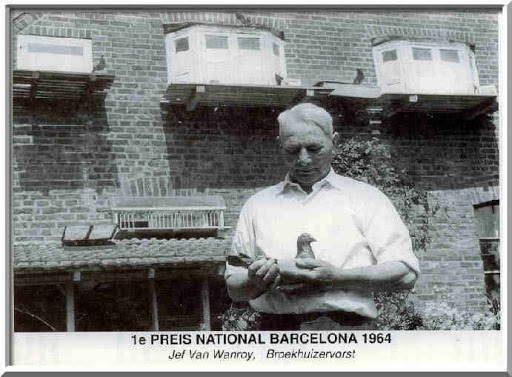
Jef Van Wanroy was a farmer who reared Shire-type horses and he became involved with pigeons during his teens, but after leaving the sport for a period he returned after the war with a serious intent, in 1946, at the age of 42. He brought to the village of Broekhuizenvorst the best that he could purchase. His ambition was to become the best at overnight racing in the Netherlands. To do this he acquired from the best long distance birds available. From a local butcher name Steegs, he bought pure Bricoux and from his friend (regarded by many as the best ever long distance flyer into Belgium or Holland) Staf Dusarduyn he obtained some of his best Delbars.
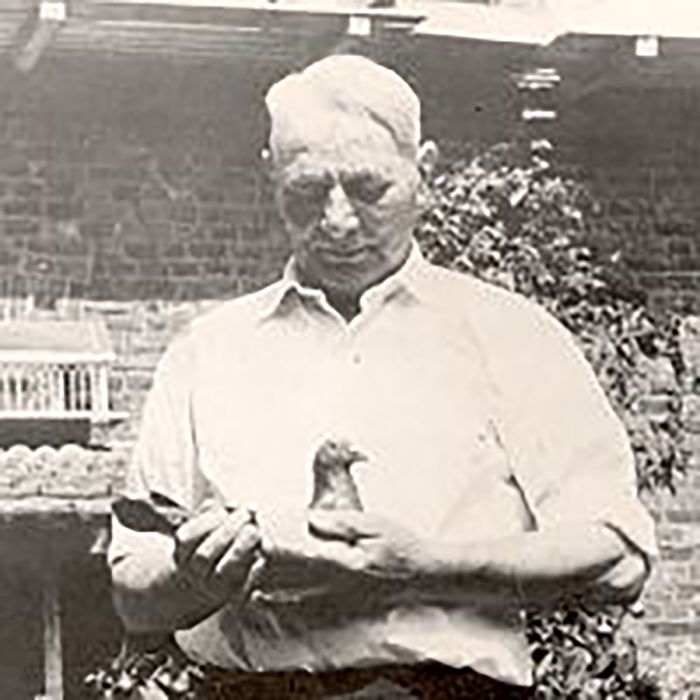
Van Wanroy also bought birds from Fabry senior of Liege which included the Hansenne stock, especially descendants of the “Bronze” and the “Koningen”. In fact, the traditional bronze of the Van Wanroy’s famous blacks derives from Fabry’s famous ‘Bronze’. Also another important addition to his stock was the famous ‘11’ or the Hornstra hen. Interestingly in the 1950s Wanroy introduced Meesters of De Heen bloodlines from the great Zilvervosje which also played an important part in the evolution of the Aarden strain and dynasty.
The name “Jef Van Wanroy” may not have been familiar to the English speaking fanciers, but in Holland it was and is a household name. Van Wanroy kept only 25 pairs of birds and specialised in 500, 600 and 700 mile races. (especially overnight). In 15 years he entered 242 birds in “grote fond” (long distance) races winning 196 prizes. Among those prizes were
1st, 4th, 21st and 24th National Marseille,
1st and 3rd National Barcelona,
1st and 7th National St. Vincent,
2nd and 9th National Dax and
3rd and 4th National Marseille.
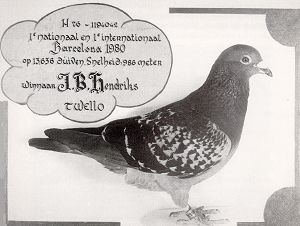
In 1971 Jef Van Wanroy died, his early death caused a shock to the pigeon world. It was however the birth of the 2nd phase of the Van Wanroy story. The Van Wanroy family wanted to sell all the pigeons together, and first to obtain them was Anton Van Haaren from Heesch. He had the Van Wanroy birds at the top of his most desired list for some time. After difficult negotiating Van Haaren set up the deal and transferred all the Van Wanroy crack birds including “Famous 90”, “Westerhuis”, “Maaskant 372”, “Hartje” “Oude Spin”, “113”, “11” etc.
The arrival of the Van Wanroy’s at Heesch, especially the lines of the “11” was the beginning of a very successful time for the loft of Anton Van Haaren. The pure Van Wanroy’s were and are the perfect cross in families like the Aardens and Van De Wegen’s, with these crossings listing fantastic results for Van Haaren with 15 top 20 national prizes. Such results, and the breeding values of the Van Wanroy stock lead to many fanciers including the world famous Hans Eijerkamp and sons to make a visit to Heesch.
As well as the birds that went to Anton Van Haaren, birds were also purchased by Van Wanroy’s fellow villager Jan Hendrix. Jan Hendrix had known Van Wanroy from the age of 12. After Van Wanroy’s death the entire colony was offered to Hendrix who famously said “ I wanted to buy them, but I had no room at the time.” Because of his friendship with Van Wanroy, Hendrix already had many birds from the very best that Jef had to offer, children from the “Eitje”, “Marseilleduif”, “Mooi Oog”, etc. Especially the descendants of the famous pair of “De Westerhuis and the Famous 90, this pair left their trail through the back breeding of the most successful Hendrix birds. Indeed, this pair can be found in the father-son-grandson trilogy of Olympiad competing birds.
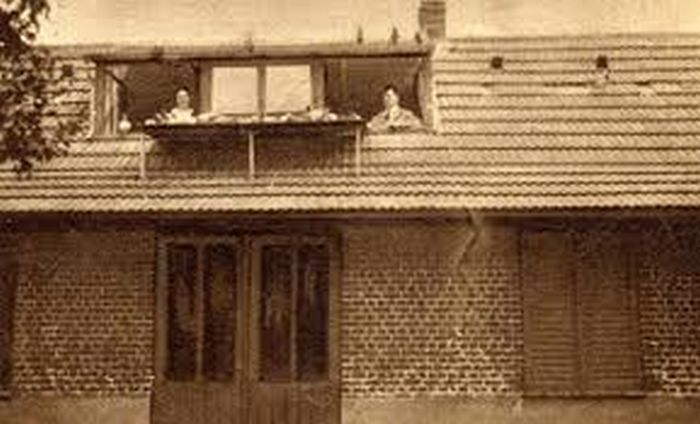
Father, “Katowitz 72” represented The Netherlands at the Olympiad in Katowice. His son “De Olympiade 84” (Katowitz 72 x daughter Marseilleduif) represented the Netherlands at the Blackpool Olympiad. “Kliene Donkere” (De Olympiad 84 x granddaughter Marseilleduif) completed the success of these now world famous bloodlines when representing the Netherlands at the Olympiad in Tokyo.
“Kliene Donkere” was crowned as the best cock of the Netherlands in 1979. That year he flew around 4,000 prize winning miles (6,435 kms), amassing a total of 16 prizes. When discussing the qualities of the cock Hendrix stated “He just asked to be basketed. Once I basketed him for Barcelona (800 miles 1,287 kms), just 2 days after he raced Orleans (350 miles 563 kms), he won 70th National Barcelona”. This type of toughness, and breeding once again sparked the interest of Hans Eijerkamp and sons with “Kliene Donkere” making the permanent trip to Brummen in 1981.

Now entering the story is J B Hendriks from Twello, not to be confused with Jan Hendrix above. Jo Hendriks (J B Hendriks) achieved international fame in the summer of 1980 when he won the race of all races, 1st International Barcelona with a Van Wanroy bird bred by Jo from 2 birds he purchased from Van Wanroy prior to Jef’s death. Jo was a lover of the Van Wanroy birds, and a friend of Jef Van Wanroy, he knew the stock birds of Van Wanroy better than anyone else other than Jef himself. In 1970 Jo Hendriks bought late bred youngsters from Jef. Within that group there was “271” a daughter of the famous pair “Maaskant x Famous 90”. Hendriks told Jef that he thought the hen was too small. As Jo Hendriks recalled in an interview
 ““That was the only time Jef got mad at me. He Spoke the legendary words wait for three years, by then she will be the best hen you have in your loft. He was right, the 271 is the dam of my Barcelona international winner”
““That was the only time Jef got mad at me. He Spoke the legendary words wait for three years, by then she will be the best hen you have in your loft. He was right, the 271 is the dam of my Barcelona international winner”
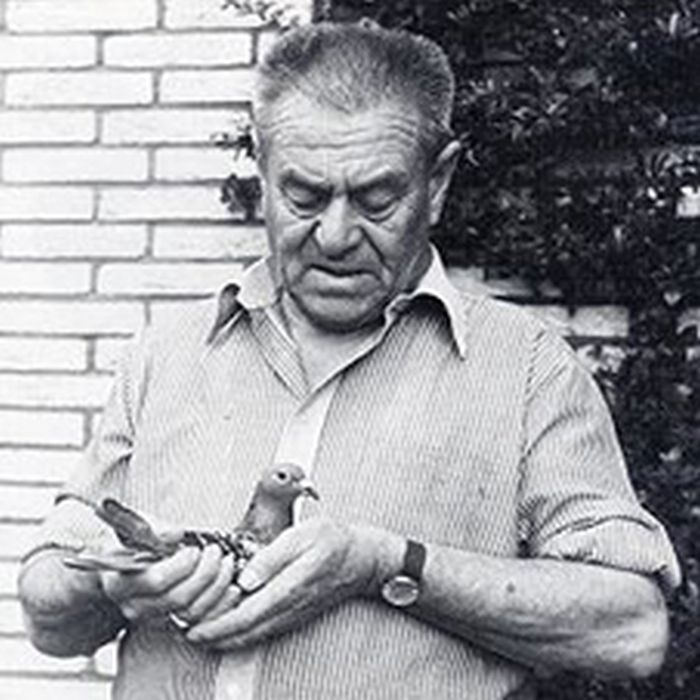
Jo bought all the direct Van Wanroy’s from Anton van Haaren in 1974, including all of the stock pigeons approximately 40 birds. Seventeen of these were children of the famous “90” hen such as “t’Hartje” 1st National St. Vincent. “De 90” was a great racer and producer having won 4th National St. Vincent 697 miles, 11th National Dax 680 miles, 36th National St. Vincent, 125th National Dax and in her last year of flying in 1970 at seven years of age 7th National Dax 7,460 birds.
The pedigree of Hendriks 1st International Barcelona winner shows line breeding to the “De 90” hen. The sire was bred from a son of “De 90” paired to his 3rd national Barcelona hen (a daughter of the 1st National Barcelona winner). Dam is the previously mentioned “271” (a full sister to 1st National St. Vincent) out of the golden pair “De Maaskantkampioen” cock and “De 90. Hendricks not only bought “De 90” but also the other crack pigeons such as; “De Westerhuis”, “De Spin”, “De Barcelona”, “De St. Vincent”, “De Maaskantkampioen”, “De Tekkel” and “De Jong Spin”. Jo Hendriks continued Van Wanroy’s breeding methods and can rightly be labelled as the successor to Van Wanroy and custodian of the Van Wanroy gene pool
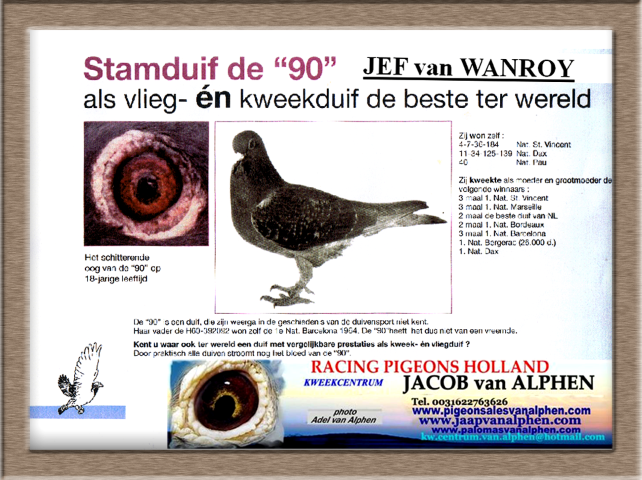
Jef Van Wanroy built up his strain by close breeding, severe selection and a few out crossings of only thoroughly tested long-distance pigeons. When any out cross was tried its youngsters were tested for two or three years before a final decision was made on keeping the blood or not. If it was decided not to keep the blood, not only was the new pigeon disposed of, but also all of its offspring.
The Van Wanroy’s are a small type pigeon possessing very soft feather, good balance, strong backs, small heads and beautiful eyes. They mature slowly and are very tame. They rarely win a prize in short distance races but at 500, 600, 700 miles they excel. As Jo got older he slowly passed the stock and descendants, to his son Ben, who has become every bit as successful as his father. A granddaughter of Hendriks 1st International (De Barcelona) winner is “Katja” a beautiful hen that won 1st National Bergerac in 96 against 16,674 b. She was also the fastest on the day against 39,069b. In her pedigree we also find the lines of the Van Wanroy stockbird “Hartje”. She is the full sister to 43rd Nat Barcelona 7,767 b.
Ben Hendriks discovered another quality of the Van Wanroy pigeons, for racing they were the perfect cross for Janssen Arendonk and Gommar Verbruggen pigeons. The crossing of the super tough Van Wanroy’s with the speed of the Janssen and Verbruggen birds meant a breakthrough at the one-day races from 350 to 500 miles (560 to 800kms). Ben never made the mistake to let these crossings dominate his loft; the pure Van Wanroys remained the number one stock family at his loft.
 “The Van Wanroy’s are a small type pigeon possessing very soft feather, good balance, strong backs, small heads and beautiful eyes. They mature slowly and are very tame. They rarely win a prize in short distance races but at 500, 600, 700 miles they excel.”
“The Van Wanroy’s are a small type pigeon possessing very soft feather, good balance, strong backs, small heads and beautiful eyes. They mature slowly and are very tame. They rarely win a prize in short distance races but at 500, 600, 700 miles they excel.”
Having obtained their first Van Wanroy’s from Jan Hendrix in 1981 the world famous Eijerkamp family strengthened their Van Wanroy stock by obtaining youngsters of Ben Hendriks from all his best Van Wanroy lines. By obtaining birds from Ben Hendriks’s Maaskant 372 x Famous 90 lines Hans, Evert-Jan and Hans-Jaap Eijerkamp had completed their purchase of Van Wanroy stock. From every successful pair Van Wanroy had, and all his fantastic racers and breeders, the bloodlines can still be found at Eijerkamp lofts.
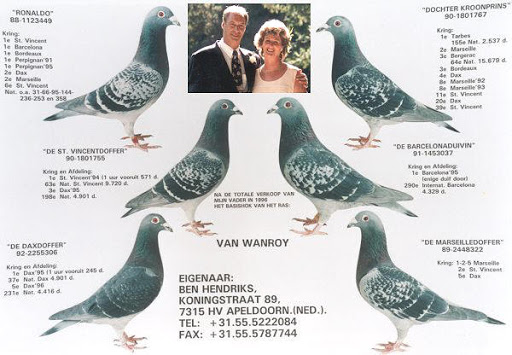
Kliene Donkere NL76-749059 as mentioned earlier was raced with great success by Jo Hendrix. Purchased in 1981 he went on to be a great breeding cock for the Eijerkamp family
The descendants of” Kliene Donkere “are truly magnificent. With children and g/children winning many national prizes including Ist International Tarbes 5,008 b. 1st National Bordeaux, 1st Nat Brive, 1st Soignies 9,374 birds and many, many more national and International prizes.
Black Giant NL91-1471583 pure Van Wanroy winner of 1st Nat Bergerac 1995 against 40,334b.
To this he added 19th Nat Bergerac ‘93 19,948 b. 41st Nat Bergerac ‘94 15,679 b. 1st federation Ruffec ‘94 1,583b. and 92nd Nat Ruffec 9,904 b. Black Giant has the very best Van Wanroy lines in his pedigree. Being inbred to the “Spin” on his sires sire and his g/dam being a granddaughter of Kliene Donkere.
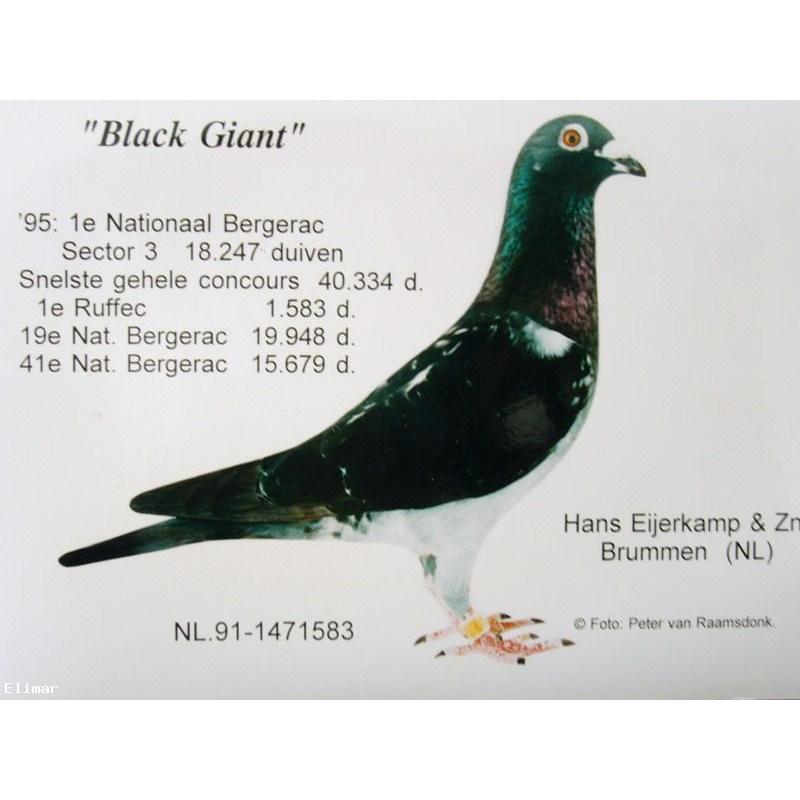
In Black Giant we first meet the lines down from the “Spin”. These lines were very important in the development of the stock. “Oude Spin” NL67-821892 was responsible for many producers especially for the lofts of Ben Hendriks and Gebr. Kuyper from Neer (who won 1st & 3rd Nat Barcelona in 1976 & 1975 with a descendant of “Oude Spin”
“Black Giant’s breeding value has also been proven over the years his descendants have won
1st Nat Barcelona 12,657 birds
1st International Pau 8,601 b.
1st Nat Bordeaux 6,164 birds
1st Nat Bordeaux 5.004 birds
1st Nat Cahors 4,887 birds
Black Cahors
1st Nat Limoges 2,942 b.
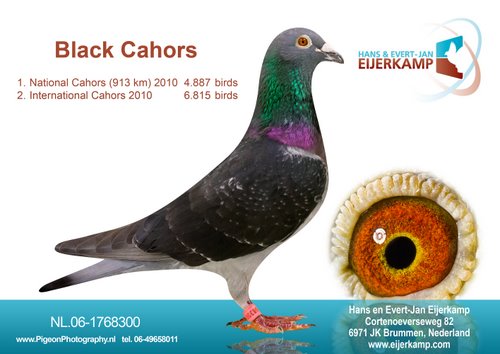
His G/G/son “ Drogba” NL04-1560775 was winner of
1st Nat Ace Pigeon Long distance WHZB in 2006
1st NAT Ace pigeon Long distance BOTB 2006 having beaten 53,207 b. over 5 races winning
7th NPO Perique 6,985 b.
25th Nat Bergerac 17,506 b.
15th NPO Brive 6,536 b.
46th NPO Perique 6,843 b.
60th Nat Bergerac 15,490 b.
Drogba is still recognised as one of Eijerkamp’s top long distance cocks, he and his children have gone on to breed many winners, in the Netherlands and around the world especially through birds from the Ponderosa stud in the UK.
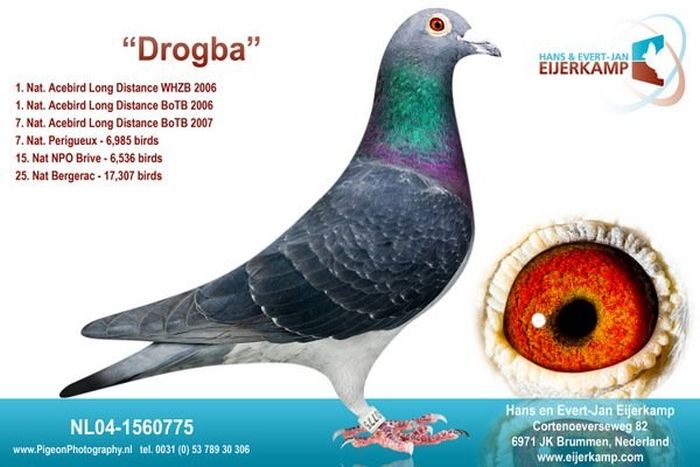
Other notable Van Wanroy stock cocks at Eijerkamp were “Friedhelm” NL97-2555993 father to
1st International Perpignan 2001 25,471 b. G/sire to 1st International Barcelona.
Famous overnight racers in Western-Europe, at National and International level, credit their successes to pure or crossed van Wanroy pigeons like for instance the 1st International winners of:
Barcelona: Kuyper’s brothers, W. v. Leeuwen, J.B. Hendriks, J. Theelan, C. Vanoppen, Vrösch-Meyers partnership, F. Menne and daughters, Danny Vagenende
Perpignan: P. v.d. Eijnden, Saya brothers, P. en H.P. Brockamp, F. Menne and daughters and Vertelman & Son.
It is striking, that so many legendary stock birds are abundantly provided with the van Wanroy bloodlines:
-Of the Kuyper’s brothers, ‘de Kromme’ and ‘Spin 807’ (father to ‘Barcelona I, II and III’).
Besides, the father to this 807 is again a son to Westerhuis x 90
‘99 Kweker’, ‘Smaragd I and II’ of Wim van Leeuwen,
‘Superkweker’ of Hermans-Hoekstra,
‘Superkweker’ of Jo van Haaren (Piet Heikants foundation hen is a half-sister),
‘Gouden Kuypertje’ of Jan Theelen,
‘Rode 50’ of Co Vertelman and Son,
‘Super Kweker’ of Herman Brinkman,
‘Ben’ of Wilfried Stiel,
‘Vlekje’ of Martha van Geel,
‘Kleine Donkere’ and the ‘Black Giant’ of Eijerkamp and Sons,
‘Stamvader 422’ of Martien Verwijlen and Son,
‘Jong Hartje’ of Jeu Vervuurt,
‘Gouden Koppel’ of Harm Vredeveld,
‘Droomkoppel’ of the late Evert Glazenburg and last but not least:
‘Blauwe Vanoppen’ of Harry and Roger Wijnands.

